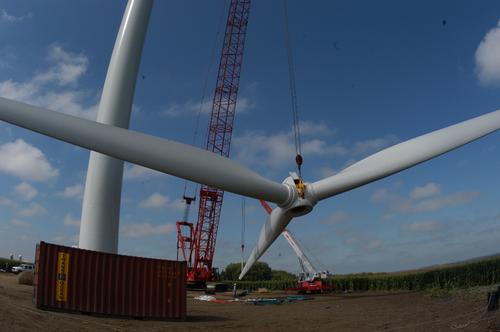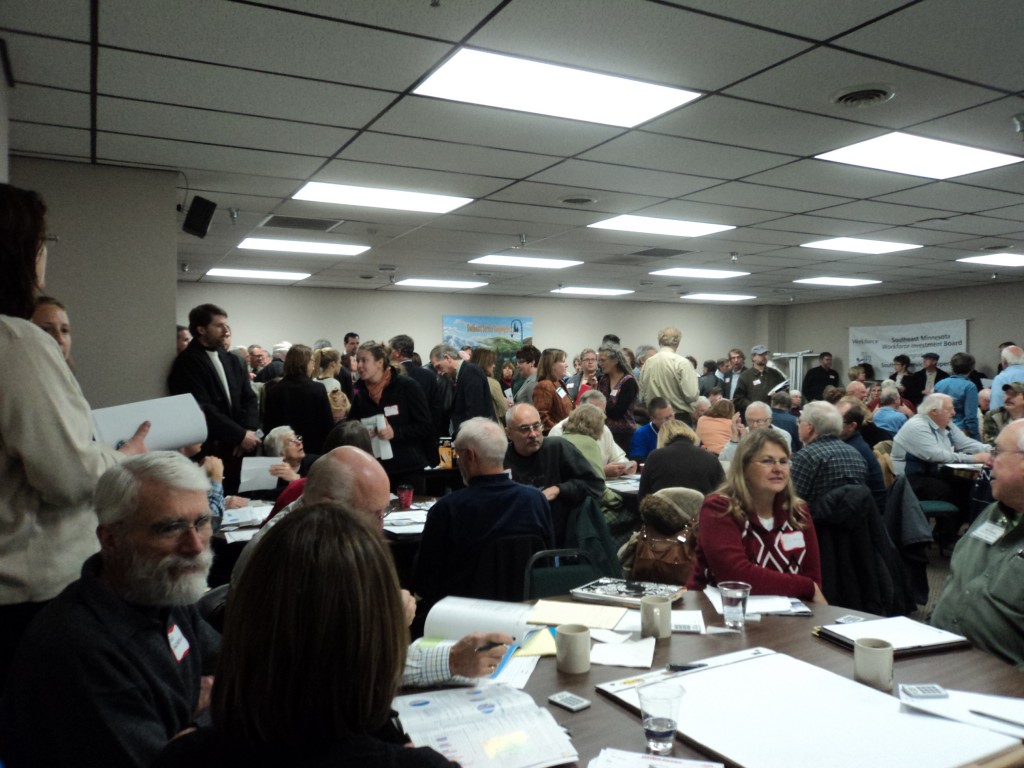PPSA Rebuttal time – due 1/28
December 27th, 2019
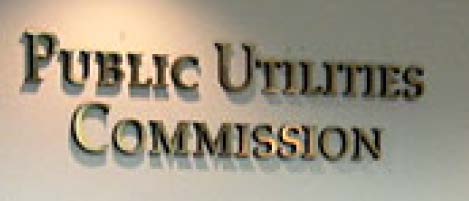
An odd notice came out today — an extension of the Power Plant Siting Act Annual Hearing comment period, “due to late-filed materials…”
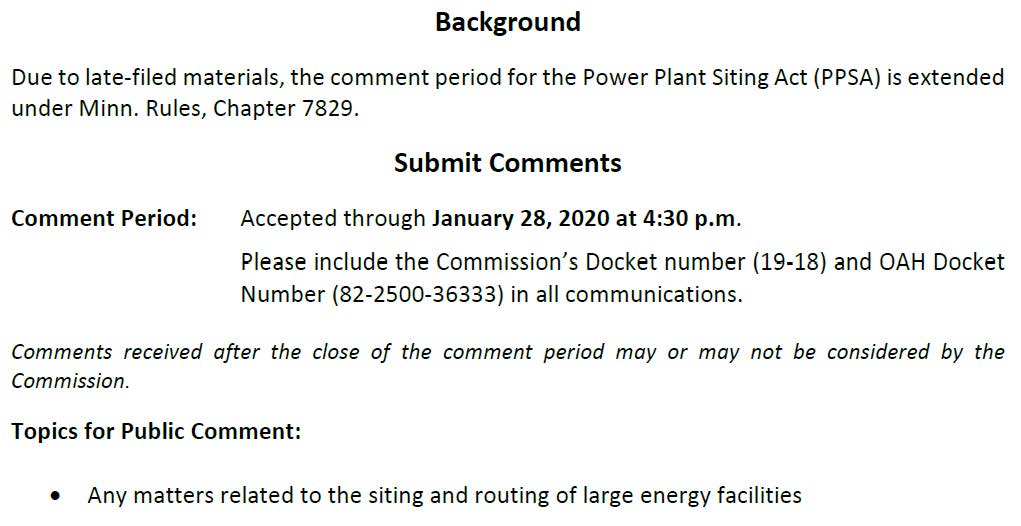
Late filed materials??? Whatever could that be… SNORT!
Naaaah, more likely than not it’s the Comments I’ve filed in all the related wind dockets, plus the PPSA dockets, regarding “ground factor” an inappropriate use of anything but 0.0 as a ground factor:
That’s all about the many wind projects that are improperly using 0.5 and 0.7 ground factor. 0.0 is the only ground factor because the turbine is elevated, and from the source to the “receptor” it is a DIRECT hit! It’s really not hard to understand.

There are so many projects, ALL of the wind projects listed in this year’s Commerce-EERA handout for the PPSA:
These projects were all permitted using bogus noise modeling with GIGO input assumption of 0.5 or even 0.7 for ground factor!!! REALLY! These:

And these:

Guess somebody is wanting time to rebut! May it means we need a contested case, eh?!?! SNORT!
But then, even developer’s expert Mike Hankard agrees that 0.5 is not appropriate for an elevated source like a wind turbine:

It’ll be interesting to see what they have to say.
To look at the PPSA Annual Hearing docket go HERE and enter docket 19-18, using 19 (year number)- 18 (docket number).
Sandpiper Scoping Meetings Scheduled
April 13th, 2016
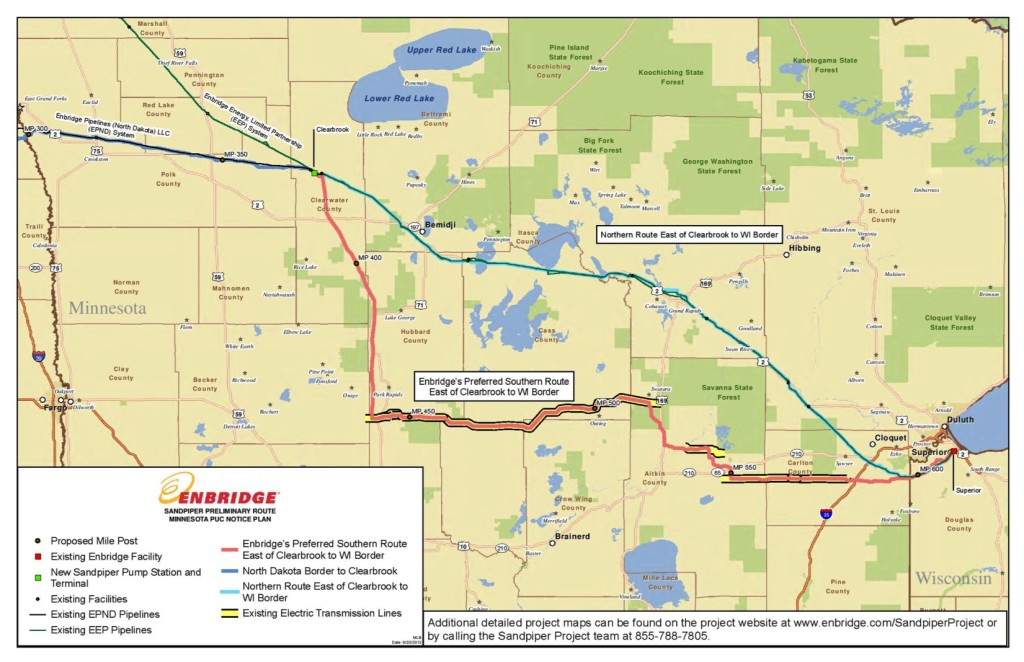 An old Enbridge map of proposed Sandpiper route
An old Enbridge map of proposed Sandpiper route
The Minnesota Department of Commerce has released Notice of Scoping Meetings for the Sandpiper pipeline:
There’s also a lot of new information posted to go along with this, routes and alternatives and modifications are posted.
To look at the entire docket, go to the PUC’s Seach eDockets page, and search for dockets 13-473 (Certificate of Need) or 13-474 (Routing Docket).
Check out this weeks filings regarding environmental review filed by Commerce:
| 20164-119946-04 | 13-473 | DOC EERA | OTHER–APPENDIX C – ACCESS ROADS TABLE | 04/11/2016 |
| 20164-119944-09 | 13-473 | DOC EERA | OTHER–APPENDIX A2 – SURVEY MAPS 70-82 | 04/11/2016 |
| 20164-119945-05 | 13-473 | DOC EERA | OTHER–APPENDIX A3 – SOIL MAPS 37-49 | 04/11/2016 |
| 20164-119944-01 | 13-473 | DOC EERA | OTHER–APPENDIX A2 – SURVEY MAPS 1-24 | 04/11/2016 |
| 20164-119946-02 | 13-473 | DOC EERA | OTHER–APPENDIX B – TAX PARCEL LIST | 04/11/2016 |
| 20164-119946-08 | 13-473 | DOC EERA | OTHER–APPENDIX E – WETLAND CROSSING TABLE | 04/11/2016 |
| 20164-119944-15 | 13-473 | DOC EERA | OTHER–APPENDIX A2 – SURVEY MAPS 109-121 | 04/11/2016 |
| 20164-119944-07 | 13-473 | DOC EERA | OTHER–APPENDIX A2 – SURVEY MAPS 54-69 | 04/11/2016 |
| 20164-119946-16 | 13-473 | DOC EERA | OTHER–APPENDIX I – ROAD AND RAILROAD CROSSING TABLE | 04/11/2016 |
| 20164-119945-01 | 13-473 | DOC EERA | OTHER–APPENDIX A3 – SOIL MAPS 1-21 | 04/11/2016 |
| 20164-119944-13 | 13-473 | DOC EERA | OTHER–APPENDIX A2 – SURVEY MAPS 95-108 | 04/11/2016 |
| 20164-119945-11 | 13-473 | DOC EERA | OTHER–APPENDIX A3 – SOIL MAPS 77-88 | 04/11/2016 |
| 20164-119944-11 | 13-473 | DOC EERA | OTHER–APPENDIX A2 SURVEY MAPS 83-94 | 04/11/2016 |
| 20164-119946-10 | 13-473 | DOC EERA | OTHER–APPENDIX F – WATERBODIES IN MN WITHIN 1 MILE DOWNSTREAM OF CROSSINGS | 04/11/2016 |
| 20164-119945-09 | 13-473 | DOC EERA | OTHER–APPENDIX A3 – SOIL MAPS 64-76 | 04/11/2016 |
| 20164-119944-17 | 13-473 | DOC EERA | OTHER–APPENDIX A2 – SURVEY MAPS 122-125 | 04/11/2016 |
| 20164-119946-12 | 13-473 | DOC EERA | OTHER–APPENDIX G – LOG FOR WELL 653274 | 04/11/2016 |
| 20164-119944-05 | 13-473 | DOC EERA | OTHER–APPENDIX A2 – SURVEY MAPS 41-53 | 04/11/2016 |
| 20164-119943-07 | 13-473 | DOC EERA | OTHER–APPENDIX A – DETAILED ROUTE MAPS 19-29 | 04/11/2016 |
| 20164-119943-09 | 13-473 | DOC EERA | OTHER–APPENDIX A – DETAILED ROUTE MAPS 30-43 | 04/11/2016 |
| 20164-119943-13 | 13-473 | DOC EERA | OTHER–APPENDIX A – DETAILED ROUTE MAPS 58-61 | 04/11/2016 |
| 20164-119943-03 | 13-473 | DOC EERA | OTHER–EAW PART 2 | 04/11/2016 |
| 20164-119943-01 | 13-473 | DOC EERA | OTHER–EAW PART 1 | 04/11/2016 |
| 20164-119945-13 | 13-473 | DOC EERA | OTHER–APPENDIX A3 – SOIL MAPS 89-101 | 04/11/2016 |
| 20164-119944-03 | 13-473 | DOC EERA | OTHER–APPENDIX A2 – SURVEY MAPS 25-40 | 04/11/2016 |
| 20164-119943-05 | 13-473 | DOC EERA | OTHER–APPENDIX A – DETAILED ROUTE MAPS 1-18 | 04/11/2016 |
| 20164-119945-15 | 13-473 | DOC EERA | OTHER–APPENDIX A3 – SOIL MAPS 102-114 | 04/11/2016 |
| 20164-119945-07 | 13-473 | DOC EERA | OTHER–APPENDIX A3 – SOIL MAPS – 50-63 | 04/11/2016 |
| 20164-119945-17 | 13-473 | DOC EERA | OTHER–APPENDIX A3 – SOIL MAPS 115-125 | 04/11/2016 |
| 20164-119943-11 | 13-473 | DOC EERA | OTHER–APPENDIX A – DETAILED ROUTE MAPS 44-57 | 04/11/2016 |
| 20164-119945-03 | 13-473 | DOC EERA | OTHER–APPENDIX A3 – SOIL MAPS 22-36 | 04/11/2016 |
| 20164-119947-02 | 13-473 | DOC EERA | OTHER–DRAFT SCOPING DECISION DOCUMENT | 04/11/2016 |
| 20164-119946-06 | 13-473 | DOC EERA | OTHER–APPENDIX D – WATERBODY CROSSING TABLE | 04/11/2016 |
| 20164-119946-14 | 13-473 | DOC EERA | OTHER–APPENDIX H – SENSITIVE NOISE RECEPTORS | 04/11/2016 |
Routing Alternate Review — Environmental Assessment isn’t enough
September 23rd, 2015
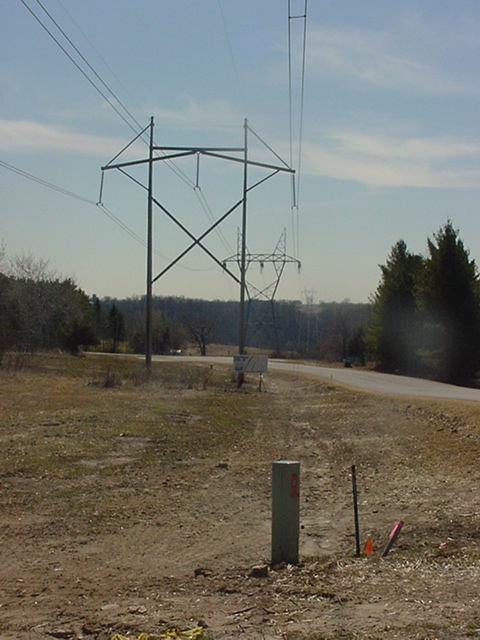 Transmission over Red Wing’s Westwood subdivision
Transmission over Red Wing’s Westwood subdivision
In routing permitting using “Alternate Review” and in wind siting permitting under Minn. Stat. Chapter 216F, exempted from environmental review, the environmental review is inadequate. An Environmental Impact Statement is necessary! DOH!
Looking at Minnesota’s draft Rules for Transmission/Utility Infrastructure siting and routing, it’s clear that the recent Minnesota Court of Appeals decision remanding the Sandpiper pipeline case to the Public Utilities Commission has implications beyond Certificate of Need.
The Court’s bottom line was:
This was based on its holding that a Certificate of Need decision by the Public Utilities Commission was a “major governmental action.”
Just as a Certificate of Need is a major governmental decision, a Siting Permit or a Routing Permit is a major governmental decision. The Minnesota statute and rules provide for “Alternate Review” for siting and routing:
And in this statute, there’s a subdivision authorizing an “environmental assessment.”
Subd. 5.Environmental review.
Throughout this rulemaking, a number of us participating have been stressing that this “environmental assessment” does not comply with MEPA. Under the logic of the “Sandpiper” decision – OPa150016-091415, the Court would agree.
Yet here are the draft rules for Siting and Routing — search for “environmental assessment” in the draft:
And Certificate of Need draft rules:
And regarding wind permits, also a major governmental decision, these are statutorily exempted from environmental review by exempting it from PPSA – Minn. Stat. 216E.03, Subd. 5 “Environmental Review.”
216F.02 EXEMPTIONS.
(a) The requirements of chapter 216E do not apply to the siting of LWECS, except for sections 216E.01; 216E.03, subdivision 7; 216E.08; 216E.11; 216E.12; 216E.14; 216E.15; 216E.17; and 216E.18, subdivision 3, which do apply.
Wind siting permits are exempt from environmental review? Public Utilities Commission issuance of wind project siting permits is a major governmental action. Nope, not compliant with MEPA.
The rulemaking process — nothing changes…
September 13th, 2015
Many thanks to the “little birdie” who brought this decades old report to my attention:
Yes, this is a report from the Minnesota Legislative Auditor from 1993, and if you read it, you’ll see little has changed is so many years… The issues raised are issues we’ve been raising in the Public Utilities Commission rulemaking for Minn. R. Ch. 7849 and 7850 (Certificate of Need and Siting/Routing). AAAAAAAAAAAACK!
For example, from the Summary:
For example, in the PUC Rulemaking for 7849 and 7850 (PUC Docket 12-1246), it’s been an over two-year-long process, and few are showing up anymore. We weigh in, some things are taken into account in the drafts, and then that disappears from the next draft. How can it feel like anything but a colossal waste of time? Yet if we weren’t there, the utilities would get everything they want. And as with the utility Certificate of Need and Siting/Routing processes, rulemaking has the same notice and public participation problems. It’s all the same, deja vu all over again.
… and also from the report …
Does this sound familiar?
So what is the bottom line of this report?
Also, we recommend the following additional changes to the Administrative Procedure Act:
… and …
In addition to changing the APA and other statutes that govern agency rulemaking, we recommend that:
EQB “Streamlining” Comments Due!
January 14th, 2013
This “streamlining” of environmental review marches onward.
COMMENTS ARE DUE TOMORROW!
I’d guess that the Gov. got an earful of what the people thought of his idea to … well… to… see E.O. 11-32, with an apparent intent to gut, slice and dice – the people don’t like it one bit:
Meetings were held, comments were given, but the only thing presented to comment on, and about which comments were directed, was the “Environmental Report Card.” But there also was a report about “Improving Environmental Review” and “Environmental Coordination and Governance.” Not one word was said by the meeting facilitators about these two reports, reports that were “approved” by the EQB before these meetings were even held! Great, just great.
Here were a few of my comments at the time, which I’ll be sending in, in technicolor:
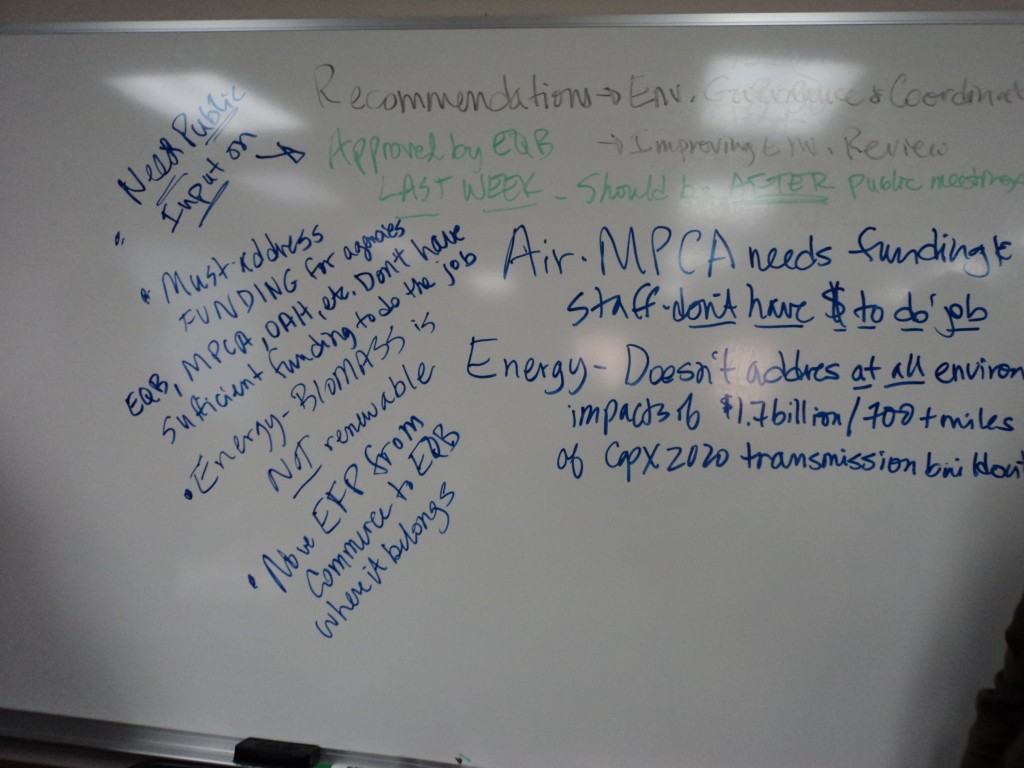
Links to the EQB Environmental Review documents:
- Evaluation and Recommendations for Improving Environmental Review
- Recommendations for Environmental Governance and Coordination
- Minnesota Environment and Energy Report Card
At the meeting, I’d asked when comments were due, and the response, after they all looked at each other, was “anytime before the Environmental Congress (sometime in March, still no date disclosed).
Now, I hear there’s a deadline of January 15. It’s not on the EQB calendar, and it’s buried on the “Environmental Congress” page. Here is that deadline and also a form to make online comments:
Click HERE for the EQB’s “Resource” page.
Note there’s a “Calendar” on the Resource Page, above Click on that CALENDAR and note that there is no mention of any deadline for comments.
Please read the two reports with something of substance (the report card is “fluff” at best):
- Evaluation and Recommendations for Improving Environmental Review
- Recommendations for Environmental Governance and Coordination
What’s most important about these is that they’ve backed off from some of the language of the draft reports, the “eliminate regulation” mantra is not so frenetic. The charge for these reports was:
1. Evaluate and make recommendations on how to improve environmental review
2. Evaluate and make recommendations for improved environmental governance and
coordination
This is the part I find disturbing — tell me, how does this relate to the charge:
The elements of the evaluation directed by EQB included:
- Look at the original intent of environmental review and consider if circumstances in Minnesota have changed such that a fundamental change in the original intent is needed.
It also claims that:
The intent of this draft report is to provide a transparent depiction of the process
that was used to develop recommendations and allow for broad public review of the
recommendations.
Where’s the “broad public review” of this report? There is NONE! It’s up to us, folks, to go over this and review it and comment on it, because so far, “broad public review” hasn’t been happening.
The part that is most disturbing to me is the way they’re trying to reframe “intent.” I don’t know where this came from, E.O. 11-32 says not one word about “intent” of environmental review — that’s a legislative mandate from decades ago. Who wrote this? Was it our good friend Charlie Peterson who wrote it, the one who facilitated these meetings, the one who facilitated the CapX 2020 Task Forces so abysmally, going far afield of the charge? Where does the writer of this report get any direction or authority to rewrite legislation, legislative history, and redefine the intent of environmental review?
Here’s what’s in the “final” report, p. 5-6, approved by the EQB on November 14, 2012:
What’s wrong with that? Take a closer look. The problem is the part about “consideration of both short and long term social and economic needs of the state.” Environmental review is to look at impacts, to provide information, and it is not about “consideration of both short and long term social and economic needs of the state.” Environmental review has never done a thorough cost/benefit analysis. Social and economic impacts are supposed to be addressed in environmental review, but “NEEDS” — let’s talk about what the social “needs” of the state are, and let’s talk about what the economic “needs” of the state are. Who decides what a social or economic “need” is, and what weight to give it? If this report is any indication, we’re in trouble. Look in Appendix D at the weights given to the groups, and you’ll see that in the identical categories, when asked to pick the most important issues, some groups get more votes than others. Whose opinion counts more? Look at their Appendix D to see.
Send in your comments on the studies, let them know you’re commenting on the studies and then tell them what you have to say, and note that something this important does indeed require a “broad public review.” At least, that’s this broad’s opinion!


